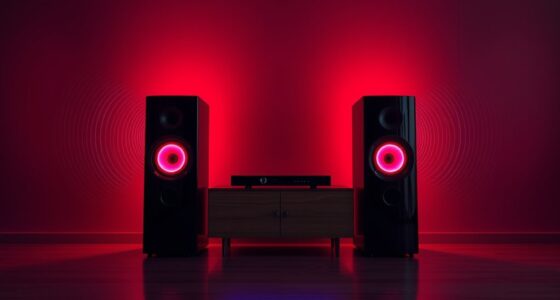When choosing between broadband and spectral noise reduction, you should consider your environment and needs. Broadband filters handle a wide range of frequencies quickly and are great for steady, predictable noise, making them simple and efficient. Spectral methods analyze sound’s specific components, offering more precise noise suppression, especially with machine learning help. To discover which approach suits you best and learn about their differences in detail, keep exploring this topic further.
Key Takeaways
- Broadband noise reduction targets all sounds across a wide frequency range, ideal for steady, predictable noises.
- Spectral noise reduction analyzes specific frequency components for targeted suppression, preserving important sounds.
- Broadband methods are simpler and computationally less intensive, suitable for real-time applications.
- Spectral techniques, often enhanced with machine learning, offer higher precision in complex noise environments.
- Choice depends on environment complexity, with broadband favoring quick, broad filtering and spectral enabling nuanced, adaptive suppression.

Have you ever been overwhelmed by loud or constant noise? It’s a common experience, and it can be frustrating to find effective ways to block out distracting sounds. When it comes to noise reduction, two main approaches stand out: broadband and spectral methods. Understanding the differences between them can help you choose the right solution for your needs. Broadband noise reduction focuses on reducing all sounds within a broad frequency range, often treating noise as a single entity. It’s straightforward and effective for consistent, steady noises like engine hums or air conditioning sounds. Spectral noise reduction, on the other hand, explores more deeply into the sound’s structure, analyzing the frequency components to target specific noise patterns. This approach is more precise, making it useful for environments where certain sounds need to be preserved while others are minimized. Machine learning has revolutionized how audio filtering is applied in noise reduction. With intelligent algorithms trained on vast data sets, machine learning models can distinguish between voice signals and background noise with high accuracy. These models “learn” the characteristics of various sounds, enabling more effective broadband or spectral noise filtering. For instance, in a crowded café, machine learning-powered audio filtering can suppress the chatter while keeping your voice clear during a call. This adaptability makes spectral methods particularly advantageous, as they can identify and suppress specific noise sources without degrading desired sounds. Unlike traditional filtering techniques that might blunt all frequencies uniformly, machine learning-driven spectral filtering adapts dynamically, preserving clarity and naturalness. Additionally, advancements in audio signal processing have further enhanced the precision of noise suppression techniques. If you’re designing a noise reduction system, consider the environment and your priorities. Broadband filtering is simpler and less computationally demanding, making it suitable for real-time applications where quick responses are needed. Spectral filtering, however, offers a higher degree of precision, especially when combined with machine learning. This combination allows for smarter noise suppression that adapts to changing conditions, such as varying background sounds or different environments. For everyday use, these sophisticated techniques can greatly improve your audio experience, whether during video calls, listening to music, or working in noisy settings. Ultimately, the choice hinges on whether you prefer a straightforward, broad approach or a nuanced, targeted one. Both methods, enhanced by advances in machine learning, are transforming how we manage noise, helping you regain clarity and focus amid chaos.
Frequently Asked Questions
How Does Broadband Noise Reduction Affect Audio Quality?
Broadband noise reduction can impact your audio quality by effectively reducing background interference across all frequencies, making your sound clearer. However, it might also cause some loss of detail because it applies broad filtering, which can lead to frequency masking of desired sounds. You may notice a slight dullness or muffling, especially in complex audio, but overall, it helps eliminate constant noise without overly sacrificing audio fidelity.
What Are the Limitations of Spectral Noise Reduction?
Think of spectral noise reduction as a finely tuned microscope that sometimes struggles with spectral resolution, making it hard to distinguish between noise and desired sound. Its limitations include difficulty with complex audio where frequency masking occurs, causing some noise to slip through or parts of the original signal to be unintentionally suppressed. This delicate balance can lead to artifacts, reducing audio clarity and making perfect noise removal a challenging feat.
Can Both Methods Be Used Simultaneously for Better Results?
Yes, you can use a dual method or combined approach for better noise reduction results. By applying broadband and spectral techniques together, you leverage the strengths of both—broadband for general noise suppression and spectral for precise, frequency-specific filtering. This dual method helps you achieve cleaner audio, minimizing artifacts and preserving clarity, especially in challenging noise environments. Experimenting with both techniques can markedly enhance your overall audio quality.
Which Noise Reduction Method Is Preferred for Live Recordings?
Think of noise reduction as tuning a radio to clear static—spectral methods are your best bet for live recordings. They excel in real-time processing, sculpting sound on the fly like a skilled artist. Plus, spectral techniques often fit better with equipment compatibility, ensuring smooth operation without hiccups. So, when capturing live, choose spectral noise reduction to keep your sound crisp and professional, even amidst the chaos of a live environment.
How Do Different Environments Impact the Effectiveness of Each Method?
In urban settings, broadband noise reduction often struggles with constant, low-frequency sounds, making spectral methods more effective because they target specific noise frequencies. In quiet environments, broadband techniques work well since there’s less background noise to filter out, allowing clearer audio. Your choice depends on the environment; spectral methods excel in noisy, dynamic settings, while broadband suits calmer, quieter spaces.
Conclusion
When choosing between broadband and spectral noise reduction, you’re fundamentally selecting how smoothly or precisely you want to refine your sound. While broadband offers a gentle touch, spectral provides a more detailed approach. Neither is perfect, but each can subtly enhance your listening experience. With a little experimentation, you’ll find the balance that feels just right, quietly transforming your audio into something clearer and more enjoyable without drawing too much attention to the process.









